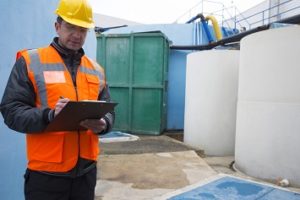If you own or operate an underground storage tank (UST), you may wonder what regulations apply to your operations. For instance, are you regulated under the U.S. Environmental Protection Agency (EPA) or the Department of Transportation’s Pipeline and Hazardous Materials Safety Administration (PHMSA), or both? Yesterday we reviewed the UST jurisdiction for the EPA and PHMSA. Today we will take a look at some scenarios where there is joint jurisdiction between the EPA and PHMSA. Remember, determining agency jurisdiction can be difficult and should be treated on a case-by-case basis.

idealistock / iStock / Getty Images Plus / Getty Images
Scenarios
In all these scenarios, when the pipeline operator and the storage or breakout tank operator are the same, the change in jurisdiction occurs at the first meter, valve, or isolation flange, at or inside the facility property. When the pipeline operator and the storage or breakout tank operator are not the same, the change in jurisdiction occurs at the change of operational responsibility or at the first meter, valve, or isolation flange, at or inside the facility property. Typically, the jurisdiction over a component of a complex is determined by the activity occurring at that component. An activity might at one time subject a facility to one agency’s jurisdiction, and a different activity at the same facility using the same structure or equipment might subject the facility to the jurisdiction of another agency.
Scenario 1: A Product Tank (Storage)
The scenario is two product storage tanks and a loading area within the property line with an isolation flange at the property line. Basically, the EPA has jurisdiction for the tank and all activities within the property line, including loading areas, until the isolation flange, where PHMSA takes over jurisdiction.
Scenario 2: Product Tank (Storage) at a Processing Plant
In this scenario, there is a product storage tank within the same property as a processing plant. The EPA has jurisdiction for the tank and for the operations within the facility property line after the first valve, into the tank, out of the tank to the processing facility, after which it shares jurisdiction with PHMSA from the first pump to the property line where PHMSA takes over.
Scenario 3: Product Breakout and Storage Tank
A. Truck delivers product to a facility and there are valves at the property line: the EPA and PHMSA share jurisdiction for the tank. The EPA has jurisdiction from the loading area where the truck delivers the product to a pipeline that leads to the tank. When the product leaves the tank through a pipeline to a main pipeline outside the facility property, PHMSA and the EPA share jurisdiction from the tank to the last valve before the property line where PHMSA takes over.
B. Facility transfer product from the tank through a pipeline to a truck, and there are pumps and valves within the property line: the EPA and PHMSA share jurisdiction for the tank. The EPA has jurisdiction from the tank to the loading area where the product is loaded in the truck. If the product leaves the tank through a pipeline to the main pipeline outside the facility property, PHMSA and the EPA share jurisdiction from the tank to the last valve before the property line where PHMSA takes over.
Scenario 4: Product Breakout and Storage Tanks at a Refinery
A. Product storage tank with a loading area and valves at the facility line: The EPA has jurisdiction for the tank and from the tank to a loading area where the product is transferred to a truck. The EPA also has jurisdiction from the refinery to the product storage tank through a pipeline to the pumps at the facility line where PHMSA takes over.
B. Product storage and breakout tank with valves, meters, and pumps within the property line: The EPA and PHMSA share jurisdiction for the tank and from the first valves within the property line to the tank. The EPA has jurisdiction from the tank through the pipeline to the refinery. If product leaves the tank directly through a pipeline to a main pipeline outside the facility property line, the EPA and PHMSA share jurisdiction from the tank to the valves at the property line where PHMSA takes over.
